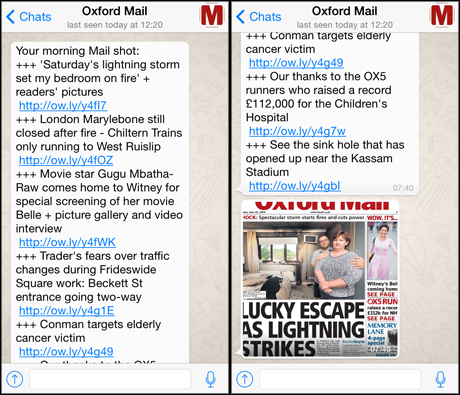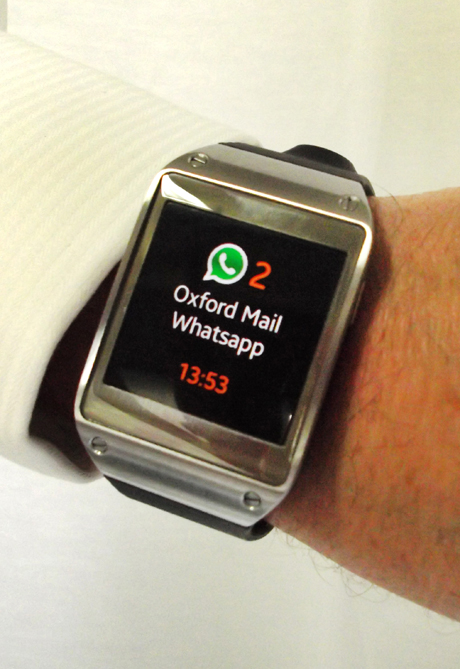Social media has changed the way news organisations deliver their stories to the reader, but with networks like Twitter and Facebook an article must compete with the growing buzz of digital conversation.
As a result, the Oxford Mail has set up a new service through WhatsApp, the private messaging smartphone application, to deliver the most important news straight to the reader’s pocket.
“It’s much more direct in turning around saying ‘come and read our story’,” Jason Collie, assistant editor of the Mail told Journalism.co.uk.
“Instead of hoping that yours is the one out of six or seven potential competitors that will be picked up by the readers.”
The WhatsApp service has been running for three weeks, since 2 June, and has amassed over 200 followers since.
Readers sign up by adding the designated phone number to their address book and sending the Mail a message detailing what kind of updates they would like to receive – news, sport, or a combination of the two.
“We limit ourselves to one morning broadcast, in which we give the best five or six stories from that day’s paper and online that morning,” Collie said. “And then if there’s any big breaking stories, like a murder or a significant incident that’s closed a street, or traffic news.”
The public service announcements around traffic have had the most positive feedback so far, said Collie, as well as appeals for information about missing persons, accompanied by a photo.
Limiting the number of messages to two or three alerts a day is important though, he said, as it stops readers becoming “desensitised” to the alert. It is not a “bulk medium”, he said, so morning and evening announcements linking to the top stories have worked best.
Screengrab from the Oxford Mail’s WhatsApp service
“The alerts all link back to a story online,” he said, “so the website can only benefit. The A40 bus fire last week has been the most successful story on WhatsApp by a mile and we’ve had almost 150 click-throughs on the page.
“In the big wide scheme of things 150 is not a huge, but it’s another 150 that we possibly wouldn’t have got so we can see this level of engagement for breaking news.”
WhatsApp traditionally limit the number of people to whom a user can send ‘broadcasts’ to 250, an issue that the BBC overcame for their WhatsApp Indian election coverage by speaking to the company directly. For a smaller organisation like the Mail, Collie said it would simply be a matter of creating new broadcast groups of individuals as demand for the service grows.
Feedback so far has been very positive, with only four people unsubscribing, one of whom had done so because they preferred to read the news in the print edition that was delivered to their door each morning.
“It’s all about meeting different demands,” Collie said. “There is not just one homogenous Oxford Mail reader who might buy the paper or might read the website or might see [news] on Twitter. There are different people who get their news in a different way and we’ve just got to supply it.”
For those at the cutting-edge of digital technology, the Mail’s WhatsApp alerts are readable on a smart watch as well, said Collie. The owner of a smart watch himself, Collie said it can be useful for people “sat in meetings who can get the news by having a sneaky look at their watch”.
Image courtesy of Jason Collie
At present, the Mail’s WhatsApp messages, including teaser headlines, links and other information, are drawn up on a desktop computer in “five to ten minutes” then emailed to the designated handset before being sent to readers.
In the future though, Collie hopes the WhatsApp account could become a channel for user-generated content as a “two-way conversation”, an area that is already starting to bear fruit in terms of images to go with news stories.
“This thing will evolve, what we’ve done over the last few weeks doesn’t make us think we’ve cracked it and we’re already thinking about whether a third feed, just dedicated to traffic, would be very popular as well,” he said.
“We thought we’d just see how this goes rather than just throwing all our eggs into one basket and it not being as popular and letting it grow. I haven’t got the silver bullet, I’m not going to proclaim to be an expert, I’m leading on what people want.”
Journalism.co.uk’s digital journalism conference news:rewired will feature a session on how news organisations can use private social networks, led by the BBC’s Trushar Barot and Buzzfeed UK editor Luke Lewis.
Tickets are still available for the event, which will take place in London on Wednesday 23 July.





